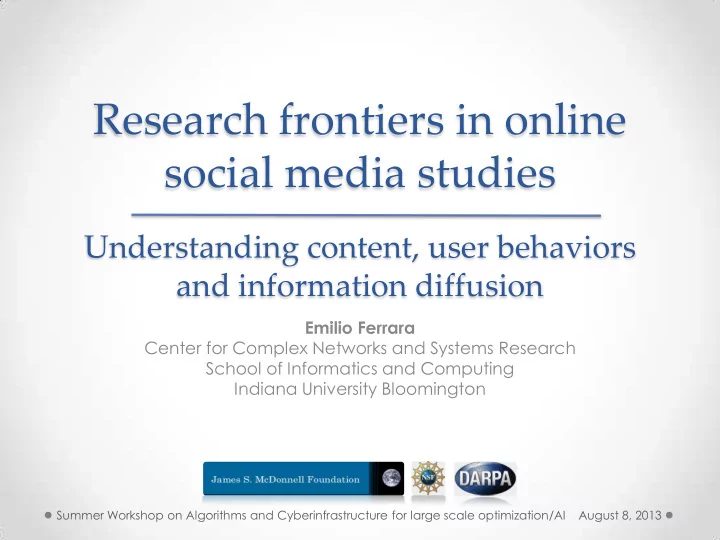

Research frontiers in online social media studies Understanding content, user behaviors and information diffusion Emilio Ferrara Center for Complex Networks and Systems Research School of Informatics and Computing Indiana University Bloomington Summer Workshop on Algorithms and Cyberinfrastructure for large scale optimization/AI August 8, 2013
Summer Workshop on Algorithms and Cyberinfrastructure for large August 8, 2013 scale optimization/AI
Summer Workshop on Algorithms and Cyberinfrastructure for large August 8, 2013 scale optimization/AI
Summer Workshop on Algorithms and Cyberinfrastructure for large August 8, 2013 scale optimization/AI
Summer Workshop on Algorithms and Cyberinfrastructure for large August 8, 2013 scale optimization/AI
Data Collection • Twitter Streaming API (10% sample of total traffic) • August, 2010 – present • ~5TB Compressed • Real-time access to data from last 9 months related to 3 themes: US Politics, Social Movements, News Summer Workshop on Algorithms and Cyberinfrastructure for large August 8, 2013 scale optimization/AI
Detecting early signatures of persuasion in information cascades Summer Workshop on Algorithms and Cyberinfrastructure for large August 8, 2013 scale optimization/AI
Scope of the project • Data acquisition in streaming scenario from Social Media (Twitter, FB) • Extraction of information tokens, so-called memes • Clustering of memes • Meme clusters classification Summer Workshop on Algorithms and Cyberinfrastructure for large August 8, 2013 scale optimization/AI
Architecture Summer Workshop on Algorithms and Cyberinfrastructure for large August 8, 2013 scale optimization/AI
Problem statement Goal : clustering a large volume of tweets, in a • streaming scenario, in topics based on their similarity. Challenges : tweets text is too sparse for • classification, we need to exploit further features: Network structure • Temporal signature • Meta-data • Summer Workshop on Algorithms and Cyberinfrastructure for large August 8, 2013 scale optimization/AI
Meme definition @Mention: the user addresses another user mentioning its username • (Twitter syntax: @) #Hashtag : the user tags its message with a “concept” (syntax: #) • URL: a message can include one/multiple URL(s) in extended or • shortened format Phrase: whatever remains after removing mentions, hashtags and • URLs, stemming verbs/nouns, removing stop-words and punctuation. Summer Workshop on Algorithms and Cyberinfrastructure for large August 8, 2013 scale optimization/AI
Advantages of using memes • More granularity: each tweet is assigned to at least one (or more) memes • Efficiency in real-time scenario: each incoming tweet is directly assigned to its meme/s without additional overhead • Memes can be aggregated each other forming clusters of topics related by content/structure similarity • We define a set of similarity measures: • Common user similarity • Common tweets similarity • Common document similarity Summer Workshop on Algorithms and Cyberinfrastructure for large August 8, 2013 scale optimization/AI
Network, memes & content relations • Social network • Memes • Content Summer Workshop on Algorithms and Cyberinfrastructure for large August 8, 2013 scale optimization/AI
Meme similarity measures • Common users similarity • Common tweet similarity • Content similarity Summer Workshop on Algorithms and Cyberinfrastructure for large August 8, 2013 scale optimization/AI
CUS: Common User Similary Cosine similarity: Example: = 0.77 Summer Workshop on Algorithms and Cyberinfrastructure for large August 8, 2013 scale optimization/AI
CTS: Common Tweet Similarity Example: P meme1 = {tweet1, tweet2, tweet5} P meme2 = {tweet1, tweet2, tweet5, tweet6} Summer Workshop on Algorithms and Cyberinfrastructure for large August 8, 2013 scale optimization/AI
CDS: Common Document Similarity We use once again the cosine similarity but using the TF-IDF matrix Summer Workshop on Algorithms and Cyberinfrastructure for large August 8, 2013 scale optimization/AI
Linear Combination Linear combination similarity score: Example: CTS(i,j) = 0.8 CUS(i,j) = 0.7 CDS(i,j) = 0.9 Different weighting schema: L(i,j) = 0.5 * 0.8 + 0.5 * 0.9 = 0.85 L(i,j) = 0.33 * 0.8 + 0.33 * 0.7 + 0.33 * 0.9 = 0.79 L(i,j) = 1 * 0.9 = 0.9 (MAX) Summer Workshop on Algorithms and Cyberinfrastructure for large August 8, 2013 scale optimization/AI
Evaluation method Building a ground-truth dataset: • Thematic, hand-picked keywords (Twitter trends) • ~ 2K tweets with keywords classified as trending • All tweets collected from a given day • The dataset contains 9 different classes (imbalanced size) Summer Workshop on Algorithms and Cyberinfrastructure for large August 8, 2013 scale optimization/AI
Goals 1.Determining how much correct is our clustering solution compared to the ground truth. 2.Determining the best trade-off in the clustering algorithm configuration considering: • Quality of obtained partitioning • Number of obtained clusters • Size of obtained clusters Summer Workshop on Algorithms and Cyberinfrastructure for large August 8, 2013 scale optimization/AI
Evaluation metrics Individual entropies: H(X), H(Y) Joint entropy: H(X,Y) Conditional entropies: H(X|Y), H(Y|X) Mutual information: Normalized mutual information: Summer Workshop on Algorithms and Cyberinfrastructure for large August 8, 2013 scale optimization/AI
Clustering algorithms We investigated different clustering algorithms: • Static hierarchical clustering • Hierarchical stream-clustering • Online K-means clustering • Algorithms have been evaluated against each • other to determine: Tweet clustering vs. meme clustering • Best clustering algorithm • Content vs. network features • Summer Workshop on Algorithms and Cyberinfrastructure for large August 8, 2013 scale optimization/AI
Stream-clustering quality Summer Workshop on Algorithms and Cyberinfrastructure for large August 8, 2013 scale optimization/AI
Cluster Number/Size Summer Workshop on Algorithms and Cyberinfrastructure for large August 8, 2013 scale optimization/AI
Summary Efficient clustering must exploit meta-data, content • and network information Introduction of memes (hashtags, mentions, URLs, • phrases) as a ‘ pre-clustering ’ step improves performance Efficient, scalable, robust clustering algorithm • adaptable for working in streaming scenario Room for performance improvement adding further • features and exploiting parameter tuning for similarity measures Summer Workshop on Algorithms and Cyberinfrastructure for large August 8, 2013 scale optimization/AI
Current/Future Work Design of a distributed architecture supporting: • o Distributed MapReduce-based storage with replication; currently evaluating: • Hadoop/Hbase • Riak • Cassandra/Solandra o Large data-storage required: • ~50M tweets/day (increasing) ~300G/day uncompressed data • Data compression (gz, lzw), support for JSON o Low latency, data-storage & access & analysis in close-to- real-time scenario Summer Workshop on Algorithms and Cyberinfrastructure for large August 8, 2013 scale optimization/AI
Recommend
More recommend